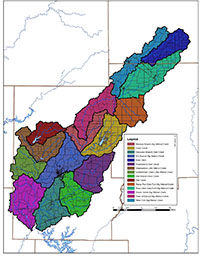Summary
The Big Walnut Creek Watershed includes the City of Greencastle and the towns of Barnard, Bainbridge, Fillmore, Jamestown, Lizton, Groveland, Morton, Manhattan, Mt. Meridian, North Salem, and Heritage and Glenn Flint Lakes. These communities are scattered evenly throughout the watershed. The watershed includes a variety of land uses including agricultural, forest and natural areas, including nature preserves, as well as urban and urbanizing land uses. The northern headwaters are almost exclusively in row crop agricultural production with pastureland and forests increasing as the watershed moves south. The southern portion of the watershed is heavily forested with pastureland and row crops scattered throughout the southern drainage. The change in glacial pattern from glaciated in the northern portion of the watershed to unglaciated near the confluence with Mill Creek results in steep, highly erodible hills and valleys which contribute to water quality issues, especially during storm flow conditions.
The Big Walnut Creek Watershed project was initiated by the Big Walnut Watershed Alliance coordinated by the Putnam County Soil and Water Conservation District for the purpose of generating interest in conservation while drawing attention to the condition of the waters within its boundaries. The Big Walnut Watershed Alliance was formed in 2006 as a result from a Section 319 grant awarded to develop the Big Walnut Creek Watershed Management Plan. The plan was completed in 2009 and a subsequent implementation grant was awarded from Section 319 funds. Utilizing these funds, projects targeting sediment were implemented from 2009 to 2012 resulting in more than 22,446,000 tons of sediment being kept out of Big Walnut Creek. Both the phosphorus and sediment goals developed as part of the planning process were met during this implementation process. Concurrently, the Indiana Department of Environmental Management (IDEM) utilized Section 319 funds and partnered with other state and federal partners, including the Putnam SWCD Upper Eel River Manure Management project, the Sycamore Trails RC&D Upper Eel River Manure Management program, Sycamore Trails RC&D Big Walnut-Deer Creek conservation buffer project and the Owen County SWCDs CORE 4 initiative, to support numerous watershed restoration projects from 1999 through 2007. As a result of the 2007 IDEM water quality assessment, IDEM identified a 96% reduction in E. coli the East Fork Big Walnut and an 82% reduction in E. coli in the West Fork Big Walnut and subsequently removed six segments of Big Walnut Creek from the 2010 impaired waters list (EPA, 2009). Since the last grant, the Big Walnut Watershed Alliance continues to meet on a regular basis promoting water quality awareness, watershed tours and canoe trips to highlight water quality.

